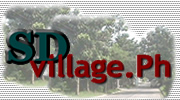 Implementation of the project included four groups of activities:
- Integration into the community. The field workers moved
into the community, introduced the project, met with the community leaders, and became
accustomed to the island situation. This integration process provided information
necessary for planning activities with respect to the community and the marine
environment. Surveys were initially made to collect data on socio-economics, demographics,
environmental and resource knowledge, and perceived problems of community. The composition
and abundance of coral reefs and fishes were assessed, and status of the island’s
resources was documented. The level of the community’s environmental awareness was
also determined.
- Education. Although education was continuous throughout
the project, it was more intensive in the initial stage. Focus was on marine ecology and
its importance, and resource management rationale and methods. During the education
process, community problems and their potential solutions emerged.
- Core group building. Existing community groups were
identified, and the formation of new group/s was facilitated. This approach was based on
the premise that the logical way to implement management solutions was through special
island work groups with close ties to the existing traditional island political structure.
Since the project intended to provide funds for a community education center adjacent to
the marine sanctuary, the first group to emerge was the one responsible for the center
construction. Similarly, as the concept for the marine reserve took shape, individuals
interested in marine conservation organized themselves and formed a committee called the
‘marine management committee’. This later became the working group implementing
the marine reserve management scheme for the island.
- Formalizing and Strengthening Organizations. Once
legitimized, the groups were provided with skills-improvement workshops in communication
and group dynamics, cooperatives, and marine management. Links with outside organization
such as the Bureau of Fisheries, the municipal councils, Silliman University, were
encouraged.
An area was established as fish sanctuary where all fishing
activities are prohibited to allow the stocks to recover. Although it initially met some
resistance, the strategy was slowly accepted by the community. After undergoing some
training, the local fishermen were deputized to be the coastal law enforcer and became an
active partner in the management of the coastal resources.
The declaration of the Apo Island as a Protected Landscape
and Seascape on August 9, 1996 (Proclamation No. 438) and the support of the barangay
council and municipal officials, strengthened the awareness of the residents of the island
regarding the importance of conserving the marine resources in the area. The people
started to actively participate in data gathering, attending meetings and training, and
other project activities.
 As a protected area under
the National Integrated Protected Areas System, Apo Island is being administered by the
Protected Area Management Board composed of representatives from national and local
government, the community, and non-government organizations. This multi-sectoral group
provides a mechanism to consolidate resources and technical capacity to make sound
decisions in the management of the coastal resources of the island. As a protected area under
the National Integrated Protected Areas System, Apo Island is being administered by the
Protected Area Management Board composed of representatives from national and local
government, the community, and non-government organizations. This multi-sectoral group
provides a mechanism to consolidate resources and technical capacity to make sound
decisions in the management of the coastal resources of the island.
The community was the first to admit that their fish catch
has increased and their fishing time has decreased after the establishment of fish
sanctuary in the island. Today, fishing activities were reduced to sustainable levels,
illegal and destructive fishing practices diminished, and fish habitats protected and
managed. The community of Barangay Apo certainly deserves all the praises given them by
the communities from nearby provinces.
basic info
| initiative | strategy | critical factors | other links | home
|

